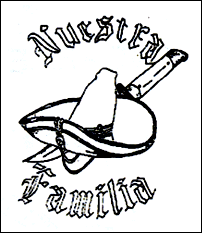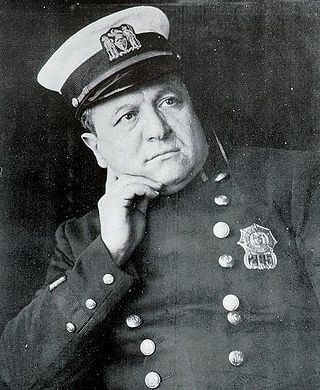
Black Hand was a type of Italian extortion racket. Originally developed in the eighteenth century, Black Hand extortion was exported to the United States in the later nineteenth century with Italian immigrants.

The Mexican Mafia, also known as La eMe, is a predominantly Mexican American prison gang and criminal organization in the United States. Despite its name, the Mexican Mafia has no origins in Mexico and is entirely a U.S. organization. Law enforcement officials report that the Mexican Mafia is the deadliest and most powerful gang within the California prison system.

Nuestra Familia is a criminal organization of Mexican American (Chicano) prison gangs with origins in Northern California. While members of the Norteños gang are considered to be foot soldiers of Nuestra Familia, being a member of Nuestra Familia itself does not signify association as a Norteño. Some law enforcement agents speculate that the Nuestra Familia gang, which operates in and out of prisons, influences much of the criminal activity of thousands of Norteño gang members in California. The gang's main sources of income are distributing cocaine, heroin, marijuana, and methamphetamine within prison systems as well as in the community and extorting drug distributors on the streets.
The Genovese crime family, also sometimes referred to as the Westside, is an Italian-American Mafia crime family and one of the "Five Families" that dominate organized crime activities in New York City and New Jersey as part of the American Mafia. The Genovese family has generally maintained a varying degree of influence over many of the smaller mob families outside New York, including ties with the Philadelphia, Cleveland, Patriarca, and Buffalo crime families.

The Chicago Outfit is an Italian-American Mafia crime family based in Chicago, Illinois, which originated in the city's South Side in 1910. The organization is part of the larger Italian-American Mafia.

Giuseppe "the Clutch Hand" Morello, also known as "The Old Fox", was the first boss of the Morello crime family and later top adviser to Giuseppe "Joe the Boss" Masseria. He was known as Piddu and his rivals the Castellammarese knew him as Peter Morello. He was famous for having a one-fingered deformed right hand that resembled a claw.

The Morello crime family was one of the earliest crime families to be established in the United States and New York City. The Morellos were based in Manhattan's Italian Harlem and eventually gained dominance in the Italian underworld by defeating the rival Neapolitan Camorra of Brooklyn. They were the predecessors of what eventually became known as the Genovese crime family.
Salvatore "Toto" D'Aquila was an early Italian-American Mafia boss in New York City of the D'Aquila crime family, what would later become known as the Gambino crime family.

Joseph Petrosino was an Italian-born New York City Police Department (NYPD) officer who was a pioneer in the fight against organized crime. Crime fighting techniques that Petrosino pioneered are still practiced by law enforcement agencies.
Shotgun Man is an alleged assassin and serial killer active in Chicago, Illinois in the 1910s, to whom murders by Black Hand extortionists were attributed. Most notably, Shotgun Man killed 15 Italian immigrants from January 1, 1910, to March 26, 1911, at "Death Corner," a notoriously violent Italian immigrant neighborhood at the intersection of Oak Street and Milton Avenue in what was then Chicago's Little Sicily. The area was notorious for violence committed by Italian immigrants and Italian-Americans, both independently and as a result of Italian gangs, the Mafia, and Black Hand feuding and vendettas. In March 1911, the so-called Shotgun Man reportedly murdered four people within 72 hours.

Mario "The Shadow" Gigante was an American mobster in New York City who served as a caporegime for the Genovese crime family. He was the elder brother of late family boss Vincent "The Chin" Gigante.

The Detroit Partnership is an Italian-American Mafia crime family based in Detroit, Michigan. The family mainly operates in Detroit and the Greater Detroit area, as well as in other locations including Windsor, Ontario; Toledo, Ohio; and Las Vegas.
Mexikanemi, also known as the Texas Mexican Mafia, is a Mexican-American prison and street gang established in the Texas Department of Criminal Justice prison system in 1984. It functions separately from the original California Mexican Mafia, and members consider themselves primarily tied to the area of Aztlán, formerly Mexican territories in the southwestern United States. The group engages in a wide range of illegal activities including drug trafficking, loan sharking, and money laundering.

The Breed Motorcycle Club was a one-percenter motorcycle club that was formed in Asbury Park, New Jersey in the United States in 1965. The club disbanded in 2006 after numerous prominent members were indicted on racketeering and drug trafficking charges.

Black Hand extortion was a criminal tactic used by gangsters based in major cities in the United States. In Chicago, Black Hand extortion began around 1900 and had all but faded away by 1970, replaced by the Mafia. The Mafia was initially organized by Johnny Torrio and further organized by Al Capone into the extant Chicago Outfit sometime later. Black Handers in Chicago were mostly Italian men from Calabria and Sicily who would send anonymous extortion notes to their victims emblazoned with a feared old country symbol: the "Black Hand". The Black Hand was a precursor of organized crime, although it is still a tactic practiced by the Mafia and used in organized crime to this day. The Black Hand gangsters of this time period differed from the Mafia by lacking formally structured hierarchies and codes of conduct, and many were essentially one-man operations. Black Hand blackmail was also common in New York, Boston, and New Orleans. Victims would be threatened with being beaten, shot, or have their place of business bombed if they did not pay. Starting around 1909, Black Hand activity was causing difficulties for mob boss Big Jim Colosimo, a former Black Hand gangster and owner of brothels throughout Chicago. Colosimo's life was being threatened with demands for cash to ensure his physical safety. In an effort to fix the problem, he recruited Johnny Torrio, who was a member of New York's Five Points Gang at the time, to come to Chicago. Torrio would later become the famous successor to Big Jim Colosimo and mentor Al Capone as the organized crime ruler of Chicago.
Operation Power Outage was a sting operation targeted at arresting and indicting members of the criminal group Armenian Power operating in the United States. The group is accused of racketeering offenses, bank fraud schemes, kidnappings, and drug trafficking. Armenian Power which originated 20 years ago in East Hollywood and has over 200 members, has developed from a street gang into an international criminal organization.

Giosuè Gallucci, also known as Luccariello, was a crime boss of Italian Harlem in New York City affiliated with the Camorra. He dominated the area from 1910–1915 and was also known as the undisputed "King of Little Italy" or "The Boss", due to his power in the criminal underworld and political connections. He held strict control over the policy game, employing Neapolitan and Sicilian street gangs as his enforcers.
Steven Lindsay, better known as "Tiger" Lindsay, is a Canadian outlaw biker and gangster involved in an important legal case to the Hells Angels Motorcycle Club declared a criminal organization in Canada.
This is a list of organized crime in the 1900s, arranged chronologically.
This is a list of organized crime in the 1910s, arranged chronologically.











